Between 2015 and 2021, India's Renewable Energy (RE) capacity more than doubled from 40 GW to 100 GW, supplying nearly 10% of the total electricity generated in the fiscal year 2021. India has set a target of achieving 500 GW of non-fossil fuel capacity by 2030. With increasing RE penetration, it is important to analyse optimal flexibility requirements to ensure grid stability and reliability. Considering this context, Idam Infra, in collaboration with Lawrence Berkeley National Laboratory (LBNL), has conducted a study to analyse the Least Cost Pathway for Power Sector Investments for four states, namely Gujarat, Karnataka, Maharashtra, and Rajasthan
Using PLEXOS, an industry-leading energy modelling software, we have analysed the optimal fuel mix for the four states and identified optimal, least-cost pathways for meeting the 2030 requirements. Our studies find that these four states can meet ~36% or 181 GW of India's non-fossil fuel commitment of 500 GWs by 2030. Furthermore, no new thermal capacity addition may be necessary. Adequate storage (pump storage and/or battery) and other flexible resources like load shift will help maintain grid stability and reliability even during high-stress periods.
The reports for the four states are as follows:
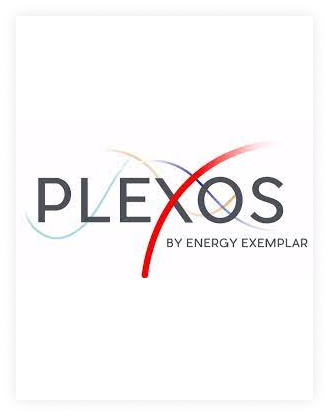
The coffee table booklet on Offshore Wind (OSW) Developments in Tamil Nadu, India, offers an overview of the Indian OSW sector with a focus on the state of Tamil Nadu.
The report draws attention to the OSW potential of the coast of Tamil Nadu and the steps taken to facilitate its development by the Ministry of New and Renewable Energy.
For more information, please visit:
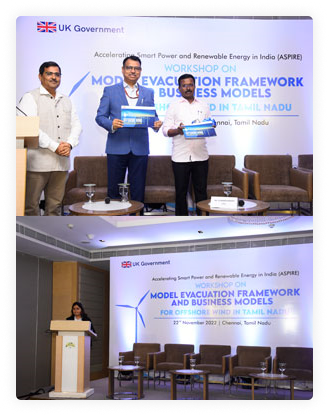
The Government of India's Renewable Energy target of 175 gigawatts (GW) has led to an unprecedented capacity addition in recent years. In the case of wind energy, the Government has not only set a target of 60 GW but has also initiated competitive bidding resulting in a significant decrease in the cost of energy. Owing to this initiative, India has successfully achieved 71 GW of Renewable Energy capacity as of 30th June 2018. For the effective utilisation of wind resources, it is necessary to utilise wind potential at these sites. Thus, the replacement of old wind turbines or 'repowering' assumes importance.
To that effect, we have launched a study report on 'Repowering of Old Wind Turbines in India' at the Indo-German Energy Day event held on 18 September at Renewable Energy Expo 2018, India Expo Mart, Greater Noida. This study event was funded by the Indo-German Energy Forum (IGEF).
For more information, please visit:
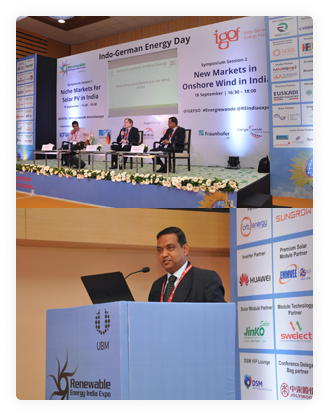
We're proud to share our work on FCDO UK India ASPIRE Programme's report on ‘India Roadmap for Offshore Wind Power Evacuation and Grid’. This report aims to empower the emerging offshore wind ecosystem in the country.
Our consulting expertise contributed to the analysis of:
▪ Technical considerations for grid integration and evacuation frameworks in Gujrat and Tamil Nadu.
▪ Viable business models for developing offshore wind plants in India.
▪Stakeholder perspectives on grid evacuation frameworks and business models (including stakeholders from the Indian Ministry of Power, Ministry of New and Renewable Energy (MNRE), National Institute of Wind Energy, and Renewable Energy developers).
▪International bestpractices through research on technical specifications and frameworks from European leaders in offshore wind.
This roadmap study aimed to:
▪ Examine India's defined trajectory of offshorewind projects until 2030 and identify its long-term transmission planning development initiatives.
▪ Discuss the planning and development of an Inter-State Transmission System (ISTS) for the Renewable Energy (RE) projects.
▪ Analyse the UK's offshore experience to propose an optimal Offshore Wind (OSW) transmission planning approach for India.
The report explores four evacuation options based on factors like:
▪ The applicability of HVAC and/or a combination of HVDC for offshore transmission systems.
▪OSW projects' distance from the shore and their compatibility with onshore transmission for effective integration.
▪ Auction strategy, technology readiness, indigenisation opportunities gain, capacity building measures.
▪ Investment channelisation for the transmission system.
Additionally, the report delves into operation and maintenance aspects of OSW evacuation, detailing crucial OSW infrastructure components which constitute the balance of the plant like:
▪ Offshore substations
▪ Reactive power compensation equipment
▪ Submarine cables
This comprehensive roadmap hopes to help stakeholders reach a consensus on the most suitable long-term planning approach for developing a roadmap for Offshore Wind Power Evacuation and Grid Integration in India by 2030.
Read the full report below :
Report on 'India Roadmap for Offshore Wind Power Evacuation and Grid’
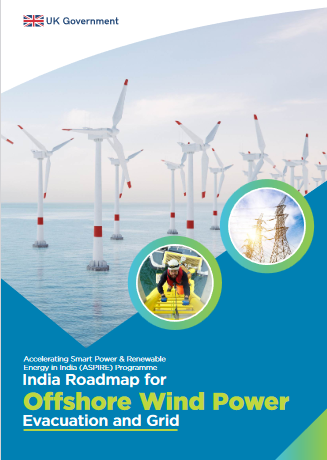
We're proud to share our work on the FCDO UK India ASPIRE Programme's report on 'Grid Integration and Model Evacuation Framework for Offshore Wind Power Development' in India. This report aims to empower the emerging offshore wind ecosystem in the country.
Our consulting expertise contributed to the analysis of:
▪Technical considerations for grid integration and evacuation frameworks in Gujrat and Tamil Nadu.
▪ Viable business models for developing offshore wind plants in India.
▪Stakeholder perspectives on grid evacuation frameworks and business models (including stakeholders from the Indian Ministry of Power, Ministry of New and Renewable Energy (MNRE), National Institute of Wind Energy, and Renewable Energy developers).
▪International bestpractices through research on technical specifications and frameworks from European leaders in offshore wind.
The report's objective is to evaluate business model options and develop efficient implementation structures for offshore wind project evacuation infrastructure. Key areas explored include:
▪ India's current policy and regulatory landscape.
▪ Successful business models from established offshore wind countries.
▪ The evolving transmission system business models in India.
▪Important characteristics and structures of the prevalent onshore transmission business models and their applicability to the #offshorewind transmission system.
We hope that this report serves as a valuable tool for stakeholders across the offshore wind ecosystem to collaboratively develop a robust evacuation infrastructure for #India's offshore wind projects. We are committed to supporting India's offshore wind ambitions and look forward to working together towards achieving these goals.
Read the full report below :
Report on 'Grid Integration and Model Evacuation Framework for Offshore Wind Power Development'

We're proud to share our work on FCDO UK India ASPIRE Programme's report on ‘Grid Integration and Model Evacuation Framework for Offshore Wind Power Development in Tamil Nadu’. This report outlines a framework for #transmissionsystem planning to integrate and evacuate power from #offshorewind projects in Tamil Nadu, a state with a significant renewable energy share (almost 45%). It aligns with the Government of India's goal of achieving 37 GW of offshore wind energy generation capacity by 2030.
Our consulting expertise contributed to the analysis of:
▪Technical considerations for grid integration and evacuation frameworks in Gujarat and Tamil Nadu.
▪ Viable business models for developing offshore wind plants in India.
▪Stakeholder perspectives on grid evacuation frameworks and business models (including stakeholders from the Indian Ministry of Power, Ministry of New and Renewable Energy (MNRE), National Institute of Wind Energy, and renewable energy developers).
▪International #bestpractices through research on technical specifications and frameworks from European leaders in offshore wind.
The report studies various #transmission and #evacuationsystems and recommends the following alternative solutions:
▪Evacuating power from individual wind farm sites through a dedicated offshore substation for each subzone.
▪ Combining B1, B2, B3, and B4 to form a single subzone, evacuating power through an offshore substation based on the rating of available transformer, treating G1 as a separate subzone.
▪Evacuating power through a combination of offshore substations and lightweight offshore substations like OTMs (based on distance from shore) by treating each subzone separately.
▪Evacuating using lightweight offshore substations (like OTMs) from combined near-shore sites in subzones B1, B2, B3, and B4.
We hope that this report empowers stakeholders to discuss, refine, and implement a robust transmission system for India's offshore wind power projects.
Read the full report bellow :

Resource Adequacy (RA) ensures a reliable power supply by planning and optimizing generation, procurement, and transmission resources while maintaining grid stability. In this context Idam Infra carried out detailed modelling studies on resource adequacy for states of Maharashtra, Karnataka, and Rajasthan. Studies for Maharashtra and Karnataka were presented at capacity building workshops held in Mumbai and Bangalore respectively. These workshops also covered presentations from esteemed guests and industry experts on overview of RA, national framework, state framework, important concepts of capacity crediting and demand forecasting, energy modelling, RA tools, transmission adequacy, and operational challenges. The workshops equipped participants with an end-to-end understanding of RA.
Read the full report bellow :
RA Workshop Report for Maharashtra
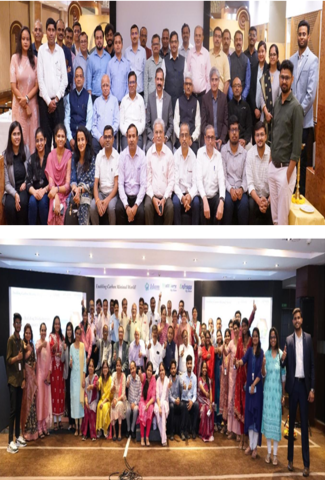
Newsletter 1 covers:
To gain further insight about Newsletter 1, please visit: iDEEKSHA Portal - Newsletter 1

Newsletter 2 covers:
To gain further insight about Newsletter 1, please visit: iDEEKSHA Portal - Newsletter 2
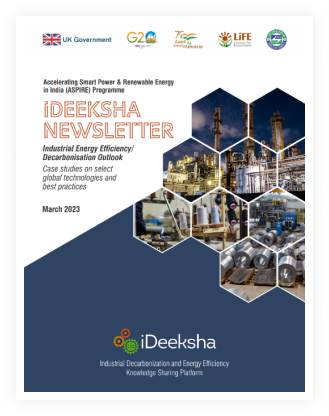
India has witnessed a substantial increase in its renewable energy (RE) capacity, which has expanded from approximately 40 GW in 2015 to almost 246 GW by July 2025. This growing RE penetration introduces several operational challenges, including limited availability during peak demand hours, heightened ramping requirements for conventional generation, and the emergence of load profile distortions such as the "duck curve". Addressing these complexities necessitates robust Resource Adequacy (RA) measures. RA plays a vital role in ensuring system reliability by enabling effective long-term planning, optimizing capacity deployment, and facilitating the seamless integration of renewable energy into the grid.
Idam Infrastructure Advisory Pvt. Ltd., after its foundational work with the Forum of Regulators in the development of State Model RA Regulations, conducted detailed RA modelling studies to evaluate the long-term generation resource adequacy in states of Maharashtra, Karnataka, and Rajasthan. The studies identified optimal capacity mix and RE expansion strategies to meet future electricity demand reliably and with adherence to reliability standards set by CEA. The studies also demonstrated how future demand and reliability standards could be demonstrated by a combination of existing, contracted, and new RE resources, without new thermal resources. By providing data-driven insights into reserve margins and system flexibility, the study aimed to support stakeholders in making informed decisions that align with India’s clean energy transition and reliability goals.
For more information, please visit:
Resource Adequacy Studies for Maharashtra

The role of Distribution Utilities in promoting and harnessing rooftop solar potential cannot be underestimated. However, there has been slow progress in India on this count, particularly in the deployment of residential rooftops by State utilities.
In this context, Idam Infra, in association with KPMG Advisory Services Private Limited has developed two knowledge products as a part of the Asian Development Bank (ADB) supported Technical Assistance (TA) programme namely, (a) Guidebook for Demand Aggregation (b) Guidebook for Utility Led Business Models for facilitating Solar Rooftop Investments in India. These guidebooks show how India plans to meet its ambitious Rooftop Solar energy targets and why identifying new business models, better engaging utilities, and developing new market mechanisms will speed up its adoption.

The ADB TA Footprints provides highlights and updates on the key interventions of the ADB TA Programme, undertaken with support from the Indian Ministry of New and Renewable Energy. This programme was implemented by Klynveld Peat Marwick Goerdeler (KPMG), India, and Idam Infra, in association with First Green Consulting Pvt. Ltd. The purpose of this initiative was to ensure the continuity of communication with all stakeholders and beneficiaries of TA.
To gain further insight about Newsletter 1, please visit: ADB TA Footprints

ADB's Technical Assistance (TA) Programme is an initiative taken under the able guidance of the Ministry of New and Renewable Energy (MNRE) that aims to remove identified barriers to large-scale adoption of Rooftop Solar (RTS) by enhancing the institutional capacity of DISCOMs and other RTS stakeholders. This programme is currently being implemented in India in the states of Kerala, Karnataka, Goa, Tamil Nadu, Telangana, and the union territories of Puducherry, Lakshadweep, and Andaman and Nicobar Islands.
For more information about Newsletter 2, Newsletter 3, and Newsletter 4, please visit:
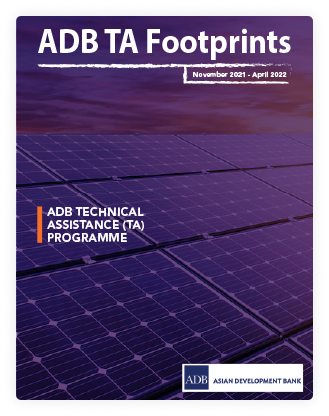
Idam Infra, with support from Prayas (Energy Group) and Shakti Sustainable Energy Foundation has authored a report on 'Transmission Reform Agenda and Action Plan for India'.
An excerpt from the report:
The transmission business is a natural monopoly and must be regulated to ensure fair access and fair prices for its users. Its regulation is necessary also to facilitate the efficiency and reliability of its operations and to encourage favourable investments. A strong and robust transmission system is the key to reducing the overall cost of power and enhancing the system's reliability. This assumes even more importance in light of the inevitable transition to integrating Renewable Energy on a larger scale. Along with a strong regulatory oversight, effective planning, pricing and participation models will be the key elements of the transmission sector reforms.
For more information, please visit:
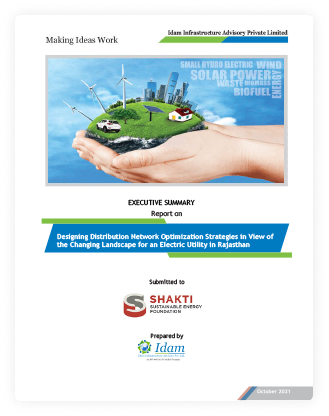
Climate Parliament engaged Idam Infra to develop an Expert Report that would study the 'Policy, Regulatory and Financial Initiatives to Augment Renewable Energy Deployment in India'. The members of Parliament from a wide spectrum of political parties submitted this Expert Report to the Prime Minister of India.
This report comprehensively and critically analyses the existing policies, schemes, and rationale for the Renewable Energy sector in the country and has a chronological plan for short, medium and long term to implement its recommendations. A few of its recommendations to the government include setting up a National Clean Energy Access mission, enforcing the National Action Plan on Climate Change (NAPCC) at the state level through amendments in the National Electricity policy, offering incentives to the states for increasing Renewable Energy purchasing obligations and compliance, and the mobilization of low-cost funds for Renewable Energy projects.
For more information, please visit:
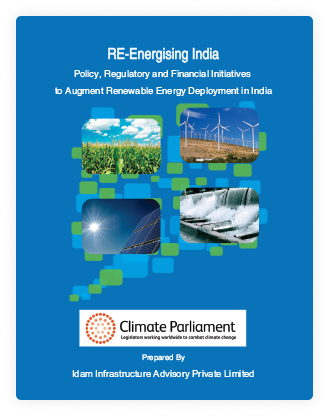
In order to examine the use cases of energy storage and study the impact of the penetration of Electric Vehicles while suggesting an appropriate regulatory framework for both Energy Storage Systems (ESS) and Electric Vehicles (EV), the Forum of Regulators (FOR) constituted a Working Group (WG). Idam Infra assisted this Working Group, under the South Asia Regional Energy Partnership (SAREP) program undertaken by United States Agency for International Development's (USAID), in submitting its report to FOR which was subsequently endorsed by the Forum. This report discusses the enabling legal and regulatory framework for Energy Storage Systems and the key issues involved in the development of the charging infrastructure for a large-scale deployment of EVs.
For more information, please visit:
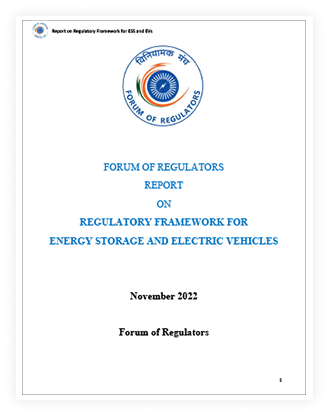
With the objective of framing guidelines for the management of Renewable Energy (RE) Curtailment for Wind and Solar Generation in line with the directive of the Hon'ble APTEL, the Forum of Regulators (FOR) constituted a Working Group (WG). Idam Infra assisted this Working Group, under the South Asia Regional Energy Partnership (SAREP) program undertaken by United States Agency for International Development's (USAID), in submitting its report to FOR which was subsequently endorsed by the Forum.
For more information, please visit:
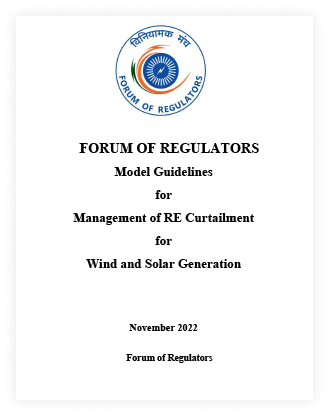
With the objective of developing Model Regulations on the methodology used for the calculation of Open Access charges for Green Energy Open Access Consumers, the FOR constituted a Working Group (WG). Idam Infra assisted this Working Group, under the SAREP program undertaken by USAID, in submitting its report to FOR which was subsequently endorsed by the Forum.
This report contains an analysis of the issues surrounding the implementation of Green Open Access according to the rules issued by the Ministry of Power on Green Energy Open Access. It also contains an analysis of the various Open Access charges issued in various states under Open Access regulations and an examination of the banking charges applicable in various states for Renewable Energy. This report suggests the various permissible charges under Green Energy Open Access that will promote Green Energy while also ensuring that the prudent costs of the distribution licensee(s) are met. It also suggests a methodology for the calculation of Green Energy Open Access charges as well as banking charges.
For more information, please visit:
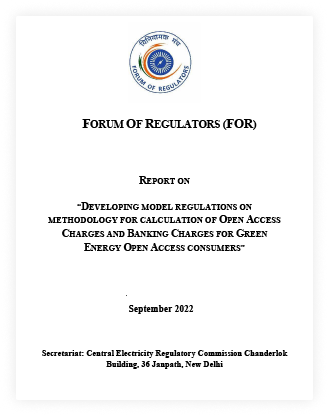
In order to assess the performance of the Power Sector in the North-Eastern States, the FOR constituted a Task Force. Idam Infra assisted this Task Force under the South Asia Regional Energy Partnership (SAREP) program undertaken by United States Agency for International Development's (USAID), in submitting its report to FOR which was subsequently endorsed by the Forum.
This report contains an assessment of the performance of the Power Sector in the Northeastern States. It analyses the performance of generation, transmission, distribution, and regulatory institutions, and compares them based on common parameters. It also provides recommendations for an improvement in the performance of the Power sector in these states along with a roadmap for a stipulated period.
For more information, please visit:
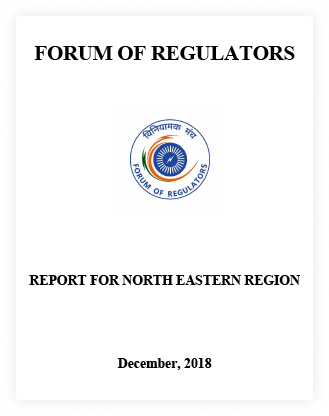
In order to understand the challenges of Biomass and Waste-to-Energy Projects and explore the opportunity of synergizing both sectors, the technical committee of the Forum of Regulators (FOR) constituted a Sub- Group under Shri R.N Sen, Chairperson, West Bengal Electricity Regulatory Commission (WBERC). Idam Infra assisted this Sub-Group, under the United States Agency for International Development's (USAID) GTG RISE Initiatives, and subsequently submitted its report to FOR who endorsed it.
For more information, please visit:
Forum of Regulator report of the Sub-Group on Challenges for Biomass and WTE Power Projects
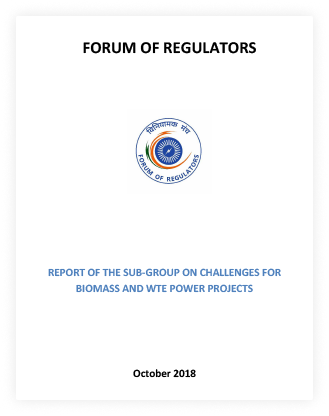
The objective of this study was to review the present Distribution Network planning practices and Capital Investment strategies to develop Capital Investment indicators addressing the evolving network requirements and technology trends for Distribution utilities. This would help achieve the most cost-effective solutions by offering the appropriate level of visibility into their distribution systems as well as their monitoring and communications capabilities.
For more information, please visit:
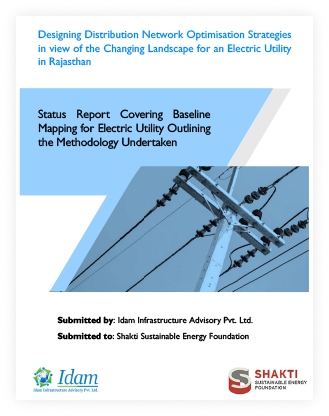
Our report titled 'Insights on Distributed Energy Resources (DERs) Policy Support in India' has been published by the esteemed Regulatory Assistance Project (RAP). This comprehensive report is co-authored by our Founding Director Ajit Pandit, Executive Director Rajiv Shukla, and consultant Aditya Marathe. It delves into the current policy landscape of Distributed Energy Resources (DERs) in India and explores the critical role of DERs in transforming India's energy sector, promoting clean energy adoption, and ensuring a more robust and sustainable power environment.
Our collaborative report offers valuable insights for policymakers, regulators, utilities, and stakeholders interested in creating a #sustainable DER ecosystem in India.
Key areas covered include:
▪ Analysis of existing DER policies and regulations
▪ Identification of challenges hindering DER adoption
▪ Best practices from international DER markets
▪ Recommendations for policy interventions to incentivize DER investments
For more information, please visit:
Report on 'Insights on Distributed Energy Resources (DERs) Policy Support in India'
